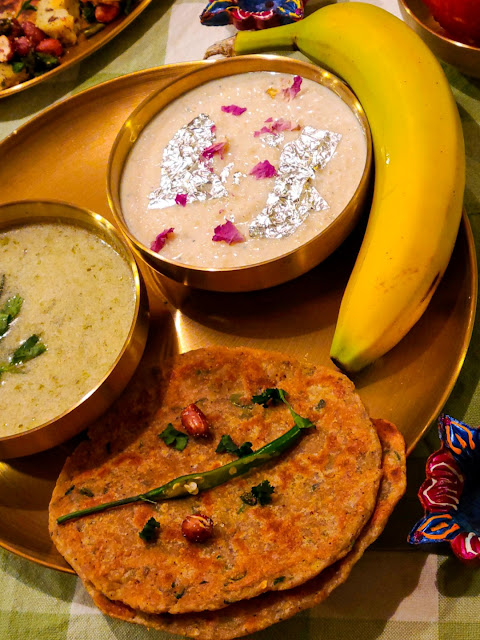Rajgira Paratha (Amaranth flour flatbread)
Rajgira or Ramdana Paratha
This is an amazing Vrat Recipe.
Amaranth is a group of more than 60 different species of grains that have been cultivated for about 8,000 years.
These grains were once considered a staple food in the Inca, Maya and Aztec civilizations.
Amaranth (Rajgira or Rajgiri) was an important staple food for the Aztecs, 15th century residents of the present day Mexico but somehow got lost along with their civilization. Amaranth isn’t technically a grain like oats, wheat or rice. The flowers of the plant are made up of minuscule, grain-like buds, the reason why this plant often falls into the “grain” category. With recent research highlighting its many uses and nutritional benefits, amaranth has been gaining importance as a super-grain.
Although amaranth has only recently gained popularity as a health food, this ancient grain has been a dietary staple in certain parts of the world for millennia.
It has an impressive nutrient profile and been associated with a number of impressive health benefits.
Amaranth is a group of more than 60 different species of grains that have been cultivated for about 8,000 years.
These grains were once considered a staple food in the Inca, Maya and Aztec civilizations.
Amaranth is a versatile and nutritious group of grains that has been cultivated for thousands of years.
This ancient grain is rich in fiber and protein, as well as many important micronutrients.
In particular, amaranth is a good source of manganese, magnesium, phosphorus and iron.
One cup (246 grams) of cooked amaranth contains the following nutrients ----
Calories: 251
Protein: 9.3 grams
Carbs: 46 grams
Fat: 5.2 grams
Manganese: 105% of the RDI
Magnesium: 40% of the RDI
Phosphorus: 36% of the RDI
Iron: 29% of the RDI
Selenium: 19% of the RDI
Copper: 18% of the RDI
Amaranth is packed with manganese, exceeding your daily nutrient needs in just one serving. Manganese is especially important for brain function and believed to protect against certain neurological conditions (3Trusted Source).
It’s also rich in magnesium, an essential nutrient involved in nearly 300 reactions in the body, including DNA synthesis and muscle contraction (4Trusted Source).
What’s more, amaranth is high in phosphorus, a mineral that is important for bone health. It’s also rich in iron, which helps your body produce blood (5Trusted Source, 6Trusted Source).
There are three very important reasons to add amaranth to your diet:
(1) Amaranth is full of protein.
Amaranth has about 13-14% protein in each seed/grain. This exceeds the protein content of many other grains. You may hear the protein in amaranth referred to as “complete” because it contains lysine, an amino acid missing in many grains.
(2) Amaranth is good for your heart.
Amaranth has shown potential as a cholesterol-lowering whole grain in several studies conducted over the past 14 years.
(3) Amaranth is naturally gluten-free.
Gluten is the major protein in many grains. Gluten is responsible for the elasticity in dough, allows for leavening, and contributes chewiness to baked products. Many people cannot comfortably or safely consume products containing gluten.
In India, we know this by the name of Rajgira. In U.P. ,my home state, we knew it by the name of Ramdana. Ramdana laddus or chikkis were often eaten in fasting, basically it used to be a vrat ingredient for us.
Ingredients:
1. Rajgira flour-1 & 1/2 cup
2. Boiled and mashed potato-1
3. Roasted cumin powder-1 tsp
4. Green chillies, green coriander and ginger finely chopped or minced
5. Rock salt
6. Black pepper powder-1/4 tsp.
Method:
*Knead a normal dough by combining all the ingredients.
* Heat tawa, grease a square aluminum foil and with the help of water, make a roti.
* Turn the foil upside down on the tawa and cover with a lid for 2 minutes approx.
* Remove the lid and carefully lift the foil.
* Drench with desi ghee or whatever oil you use in vrat.
* Flip and make a nice paratha.
Serve with vrat ki sabzi or kadhi.
Though it tastes awesome even without any accompaniment, yet you can make khatti mithi chutney of 🍅.
I served this with singhade ke aate ki kadhi, Sama ke chawal ki Kheer, aalu ki dry sabzi and fried peanuts.




Comments
Post a Comment